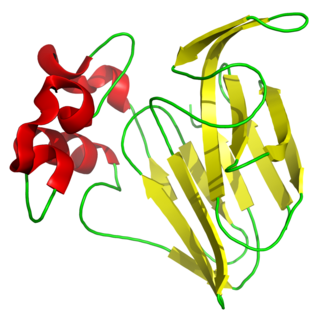
Thaumatin is a low-calorie sweetener and taste modifier. The protein is often used primarily for its flavor-modifying properties and not exclusively as a sweetener.

Uniporters, also known as solute carriers or facilitated transporters, are a type of membrane transport protein that passively transports solutes across a cell membrane. It uses facilitated diffusion for the movement of solutes down their concentration gradient from an area of high concentration to an area of low concentration. Unlike active transport, it does not require energy in the form of ATP to function. Uniporters are specialized to carry one specific ion or molecule and can be categorized as either channels or carriers. Facilitated diffusion may occur through three mechanisms: uniport, symport, or antiport. The difference between each mechanism depends on the direction of transport, in which uniport is the only transport not coupled to the transport of another solute.

Monellin, a sweet protein, was discovered in 1969 in the fruit of the West African shrub known as serendipity berry ; it was first reported as a carbohydrate. The protein was named in 1972 after the Monell Chemical Senses Center in Philadelphia, U.S.A., where it was isolated and characterized.

Miraculin is a taste modifier, a glycoprotein extracted from the fruit of Synsepalum dulcificum. The berry, also known as the miracle fruit, was documented by explorer Chevalier des Marchais, who searched for many different fruits during a 1725 excursion to its native West Africa.

Sweetness is a basic taste most commonly perceived when eating foods rich in sugars. Sweet tastes are generally regarded as pleasurable. In addition to sugars like sucrose, many other chemical compounds are sweet, including aldehydes, ketones, and sugar alcohols. Some are sweet at very low concentrations, allowing their use as non-caloric sugar substitutes. Such non-sugar sweeteners include saccharin, aspartame, sucralose and stevia. Other compounds, such as miraculin, may alter perception of sweetness itself.

Brazzein is a protein found in the West African fruit of Oubli. It was first isolated by the University of Wisconsin–Madison in 1994.

Disintegrins are a family of small proteins from viper venoms that function as potent inhibitors of both platelet aggregation and integrin-dependent cell adhesion.

Ziziphin, a triterpene glycoside which exhibits taste-modifying properties, has been isolated from the leaves of Ziziphus jujuba (Rhamnaceae).

Pentadin, a sweet-tasting protein, was discovered and isolated in 1989, in the fruit of oubli, a climbing shrub growing in some tropical countries of Africa. Sweet tasting proteins are often used in the treatment of diabetes, obesity, and other metabolic disorders that one can experience. These proteins are isolated from the pulp of various fruits, typically found in rain forests and are also used as low calorie sweeteners that can enhance and modify existing foods.

Mabinlins are sweet-tasting proteins extracted from the seed of mabinlang, a plant growing in Yunnan province of China. There are four homologues. Mabinlin-2 was first isolated in 1983 and characterised in 1993, and is the most extensively studied of the four. The other variants of mabinlin-1, -3 and -4 were discovered and characterised in 1994.
Capparis masaikai, known as mabinlang, grows in the subtropical region of the Yunnan province of China and bear fruits of tennis-ball size. The mature seeds are used in traditional Chinese medicine.

Taste receptor type 1 member 1 is a protein that in humans is encoded by the TAS1R1 gene.

T1R2 - Taste receptor type 1 member 2 is a protein that in humans is encoded by the TAS1R2 gene.

Taste receptor type 1 member 3 is a protein that in humans is encoded by the TAS1R3 gene. The TAS1R3 gene encodes the human homolog of mouse Sac taste receptor, a major determinant of differences between sweet-sensitive and -insensitive mouse strains in their responsiveness to sucrose, saccharin, and other sweeteners.

Gurmarin is a 35-residue polypeptide from the Asclepiad vine Gymnema sylvestre (Gurmar). It has been utilized as a pharmacological tool in the study of sweet-taste transduction because of its ability to selectively inhibit the neural response to sweet taste in rats. This rat inhibition appears to have high specificity to sugar (sweetener) molecules like sucrose, glucose, and saccharin as well as the amino acid glycine. As a sweet-taste-suppressing protein, Gurmarin shows signs of being reversible in nature although having little to no effect on the sweet taste sensation in humans suggesting the protein is only active on rodent sweet taste receptors.
Imperatoxin I (IpTx) is a peptide toxin derived from the venom of the African scorpion Pandinus imperator.

In biochemistry, a protein dimer is a macromolecular complex or multimer formed by two protein monomers, or single proteins, which are usually non-covalently bound. Many macromolecules, such as proteins or nucleic acids, form dimers. The word dimer has roots meaning "two parts", di- + -mer. A protein dimer is a type of protein quaternary structure.

Curculigo is a flowering plant genus in the family Hypoxidaceae, first described in 1788. It is widespread across tropical regions of Asia, Africa, Australia, and the Americas.
Serratia marcescens nuclease is an enzyme. This enzyme catalyses the following chemical reaction

Irditoxin is a three-finger toxin (3FTx) protein found in the venom of the brown tree snake and likely in other members of the genus Boiga. It is a heterodimer composed of two distinct protein chains, each of the three-finger protein fold, linked by an intermolecular disulfide bond. This structure is unusual for 3FTx proteins, which are most commonly monomeric.















